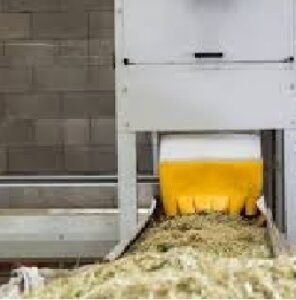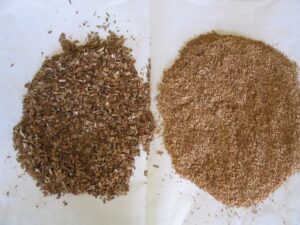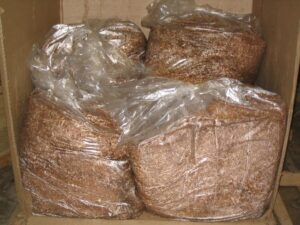Hemp Biomass Management: Excellence & Profit
Hemp Biomass Management (Part 2): Managing for Excellence and Profit
By David F. Peterson, B.S, MBA
This is the second article in a two-part series (Part 1, Hemp Biomass Management (Part 1): Technology)
Since you are reading this article, you are interested in learning how to better manage your hemp biomass feedstock. Whether the reader is just entering the world of hemp or an experienced feedstock manager, the goal of this article is to give every reader some ideas on how to better manage biomass feedstocks.
 As with all sources of natural biomass, the variability of the feedstock is the enemy of quality, operability, and ultimately profitability. The goal of managing any biomass feedstock is to reduce variability, increase operating efficiency and improve profitability. It may be difficult to quantify profit benefits, but any decrease in variation is a positive trend. Not considering how the biomass is grown or the effects of genetically altered seeds or clones, the variability in harvested hemp biomass can be reduced through five management tools:
As with all sources of natural biomass, the variability of the feedstock is the enemy of quality, operability, and ultimately profitability. The goal of managing any biomass feedstock is to reduce variability, increase operating efficiency and improve profitability. It may be difficult to quantify profit benefits, but any decrease in variation is a positive trend. Not considering how the biomass is grown or the effects of genetically altered seeds or clones, the variability in harvested hemp biomass can be reduced through five management tools:
- Feedstock management planning;
- Feedstock testing;
- Incoming feedstock specifications;
- Supply agreements; and
- Process technology design and operations.
Ideally, the hemp processor would be able to take any ‘remotely acceptable’ feedstock, process it with robust technology to produce a product that meets all the specifications 100% of the time. As we know, that situation only exists in our dreams. In the real world, dirt, contamination, seed size, seed quality, irrigation, stalk density, time in storage, moisture content, insects, disease, site differences, nutrients, weather conditions, harvesting techniques, genetic variation and transportation differences, to name just a few, are causes for variation.
These five management tools and techniques are discussed below.
Planning
The first step in managing your feedstock is an overall plan. This plan addresses the current status including processing steps and metrics at key stages, objectives and how to achieve the clearly stated goals. If you are just starting out, some questions to ask include: Where do you expect to get your feedstock? What are your feedstock acceptance standards and how will you select your suppliers? How much and what kind of feedstock is needed taking into consideration various losses, including moisture and overall product yield? Quite often these decisions can involve trade-offs between important properties. If you have an operating facility, do you understand your current feedstock variability?
An important part of any feedstock management plan is data. Wise investors and managers need good data to ensure sound decisions. Likewise, natural product-based operators need reliable data to specify equipment, design facilities, establish safe operating procedures, calculate overall mass and energy balances and produce financial proformas. As a critical metric for any operation, the estimated overall yield is based on information that uses processing assumptions, biomass data and operational data. Specific to your operations, how will yield be calculated as a key metric? To answer these important questions, what feedstock data is available and where can you go for data if it is not available? As a first stop, most suppliers can provide some basic feedstock data such as moisture and composition, and perhaps additional test results on chemical composition such as THC and other important physical properties. If the data is not available through any readily available sources, the data will be need to generated from testing.
The overall product yield, whether CBD, oil or fiber, is obviously a key metric that can vary wildly when looking at various biomass sources. To provide statistically significant conclusions, a considerable number of samples of various sources likely need to be tested to provide realistic expectations for key properties. Seasonal differences also need to be taken into consideration as well as any effects of storage. Statistical analysis of the data will help to determine when a realistic understanding is achieved, resulting in calculated averages, upper and lower control limits, process capability and estimated confidence limits. Key metrics will need statistical analysis, with the end result being key output goal estimates, such as yield, % THC, % of primary ingredient, moisture and tacking methods to monitor process performance.
Time spent on an early stage plan can save a lot of time and provide for more focused feedstock evaluations and ongoing improvements, not to mention valuable information for business plans. Often a feedstock plan involves an iterative process necessitating ‘Plan, Do, Check, and Act’ cycles to move forward as information is developed and analyzed. When completed, the biomass management plan then becomes an important tool for managing the business.
Testing

Feedstock Specifications
Armed with data and supply information, realistic incoming feedstock specifications can be published. As the principles of economic supply and demand apply, there is usually an inverse relationship between specifications versus feedstock availability and cost. Unless there is a rare situation where supply is so abundant that tight specification will not constrict supply, most specifications tend to decrease supply options and increase costs. Robust and forgiving processes technology and equipment will be able to tolerate variability in some feedstock specifications, such as stem size, seed properties, moisture, contamination, etc. to thereby lower losses.
Feedstock specifications need not be complicated. The specifications can be a simple table showing the feedstock parameters along with the acceptable ranges for each parameter. If a parameter is not crucial, the range can be quite broad to just protect the buyer from unusual conditions. For example, moisture may not be critical factor due most feedstock being well within an acceptable range, but the unusual situation of soaking wet may be an issue as well as too dry. In this situation, the specification should specify the normal range as acceptable, but reject the material that is high moisture to avoid higher drying costs, equipment issues and perhaps prevent other challenges such as mold during storage. However, on the other end of the moisture spectrum, feedstock that is too dry may be difficult to process or represent higher fire dangers, so a lower moisture reject limit is also needed. THC levels, depending on the final product, may need tighter limits on incoming feedstock.

A supply agreement between the supplier and buyer specifies all the important parameters for volume, feedstock properties, delivery and payments. Supply agreements can be complicated and could alone require volumes of information to give it proper coverage due to the many nuances of these legally binding documents. For sake of brevity and the purpose of this article, we will focus on how a supply agreement can be used to manage feedstock quality and volume. With data showing what is needed for product specification and knowing volume-based pricing numbers, the essential elements of supply agreements can be established to control variability, as well as establish price, transportation fees and delivery expectations. A supply agreement will not only establish penalties for ‘off-spec’ shipments but may also include incentives for more favorable feedstock conditions, such as higher CBD concentration plant parts, which would add to profitability. Supply agreements can also include ‘take or pay language’ to provide assurances to suppliers that have fixed costs and other risks, that they would be protected against a sudden loss of product purchases. Conversely, supply agreements can contain penalties if certain shipment metrics are not achieved, such as not meeting minimum shipments or not consistently meeting quality specifications. Overall, the objective of supply agreements is to provide the highest quality feedstock possible, i.e. feedstock with lowest practical variation, for the volume of biomass needed at a market acceptable price that is fair to both the supplier and buyer. To be successful in the long-term, suppliers need to be viewed as partners. If reputable suppliers understand they are valued, that positive relationship can lead to many intangible benefits. With supply agreements being somewhat negotiable, it is important to understand what terms are negotiable and what terms are not. Data and a good understanding of your process will help to establish fair supply agreement terms that provide for mutual profitability.
Process Technology Design and Operations
Effective process design and equipment selection is essential for managing biomass for excellence and profitability. The key to equipment selection and design is to understand how the processing equipment, storage vessels and conveyance systems will help meet final product specifications. Capital and operational costs, process safety management, environmental requirements, maintenance needs and operational requirements must also be included in the decision process. Minimal handling of feedstock is always the goal, but sometimes the cost of more highly automated systems cannot be justified, especially for smaller scale plants that are common at this stage in hemp industry development. Storage of natural materials can be especially troublesome with caking, bridging, and mold being more common issues. To prevent this, aeration or agitation is often used in storage vessels, but the design must be vetted for effectiveness for the specific biomass materials being stored.
Regarding segregation of various feedstock sources, it may make sense to keep certain sources or types of feedstock separated in storage and then blended to provide a consistent and uniform feedstock recipe for processing. Segregation of feedstock may be driven by THC levels, moisture, etc. The chemical composition of hemp materials can vary significantly due to genetics, site conditions, weather, fertilizer, management decisions, etc. With hemp it is quite common to see significant differences in chemical analyses from site to site and by cultivar. The practice of segregating various sources is used throughout bio-economy process industries. For example, trees are segregated by species so the wood fiber can be blended in pulping operations for consistent final pulp properties. As with all decisions, there is a cost to segregating feedstock inventories. A cost/benefit analysis will sort out the best decision.
Throughout the entire manufacturing process, it will be necessary to have intermediate in-process quality standards with sample testing and process metrics at significant process operations to monitor important quality parameters. If the process is in control, the quality is usually predictable.
Wrapping It Up
Managing biomass is well understood and there are ample sources of experts and other resources to help solve the toughest issues. Natural products, like hemp, represent a sustainable solution to market demands. It will be exciting to see where the hemp market goes as the world enters further into the bioeconomy.[i]
LEC Partners
is the world’s premier bioeconomy consulting group with over 150 bioenergy and biochemical experts worldwide. Our experts are world renowned leaders in their field, selected based on their education, experience, and reputation and have done thousands of projects worldwide. The group is divided into sections including biofuels, biomaterials, biochemicals, feedstocks, technologies, land & natural resources management, food & livestock production, and cannabis/hemp and provides hundreds of services including business & financial, technical & engineering, project management, legal & regulatory, and a variety of highly specialized services like due diligence, market research, risk analysis, litigation support and techno-economic analysis.NEXT IN SERIES:
Challenges In The Marketplace: Offtake Agreements – Connecting Growers with Buyers, by
LEC Partners
’s Rachael Ardanuy, J.D.[i] https://www.globenewswire.com/news-release/2020/09/15/2093501/0/en/Global-Cannabidiol-CBD-Oil-Market-Report-2020-2025-Market-to-Grow-from-967-2-Million-in-2020-to-5-3-Billion-by-2025.html
Have some questions?
Not sure where to start?
Let's start a conversation. We're here to help you navigate
the bioeconomy with confidence.
